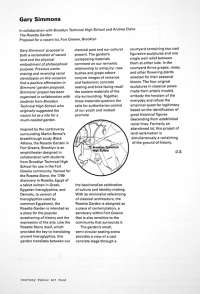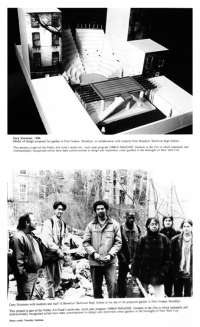In collaboration with Brooklyn Technical High School and Andrea Claire
The Rosetta Garden
Proposal for a vacant lot, Fort Greene, Brooklyn
Gary Simmons' proposal is both a reclamation of vacant land and the physical embodiment of philosophical purpose. Previous works erasing and reversing racial stereotypes on this occasion find a positive affirmation in Simmons' garden proposal. Simmons' project has been organized in collaboration with students from Brooklyn Technical High School who originally suggested the vacant lot as a site for a much-needed garden.
Inspired by the controversy surrounding Martin Bernal's breakthrough study Black Athena, the Rosetta Garden in Fort Greene, Brooklyn is an amphitheater designed in collaboration with students from Brooklyn Technical High School for use in the Fort Greene community. Named for the Rosetta Stone, the 1799 discovery in Rosetta, Egypt of a tablet written in Greek, Egyptian hieroglyphics, and Demotic, (a version of hieroglyphics used by common Egyptians), the Rosetta Garden is intended as a place for the popular questioning of history and the expression of the arts. Like the Rosetta Stone itself, which provided the key to translating classical past and our cultural present. The garden's juxtaposing materials comment on our romantic relationship to antiquity: rose bushes and grape arbors conjure images of romance and hedonism; concrete seating and brick facing recall the austere materials of the city surrounding. Together, these materials question the calls for authoritarian control of our youth and instead promote ancient hieroglyphics, this garden translates between our classical past and our cultural present. The garden's juxtaposing materials comment on our romantic relationship to antiquity: rose bushes and grape arbors conjure images of romance and hedonism; concrete seating and brick facing recall the austere materials of the city surrounding. Together, these materials question the calls for authoritarian control of our youth and instead promote the bacchanalian celebration of culture and identity-making. With its minimalist referencing of classical architecture, the Rosetta Garden is designed as a place of contemplation, a sanctuary within Fort Greene that is also sensitive to the community that surrounds it.
The garden's small, semi-circular seating arena provides a view of a cast concrete stage through a courtyard containing two cast figurative sculptures and one single wall relief between them at either side. In the courtyard thrive grapes, roses, and other flowering plants selected for their seasonal bloom. The four original sculptures in classical poses made from artist's models embody the heroism of the everyday and refuse the empirical quest for legitimacy based on the identification of great historical figures descending from established racial lines. Formerly an abandoned lot, this project of land reclamation is simultaneously a reclaiming of the ground of history.
In collaboration with Brooklyn Technical High School and Andrea Claire
The Rosetta Garden
Proposal for a vacant lot, Fort Greene, Brooklyn
Gary Simmons' proposal is both a reclamation of vacant land and the physical embodiment of philosophical purpose. Previous works erasing and reversing racial stereotypes on this occasion find a positive affirmation in Simmons' garden proposal. Simmons' project has been organized in collaboration with students from Brooklyn Technical High School who originally suggested the vacant lot as a site for a much-needed garden.
Inspired by the controversy surrounding Martin Bernal's breakthrough study Black Athena, the Rosetta Garden in Fort Greene, Brooklyn is an amphitheater designed in collaboration with students from Brooklyn Technical High School for use in the Fort Greene community. Named for the Rosetta Stone, the 1799 discovery in Rosetta, Egypt of a tablet written in Greek, Egyptian hieroglyphics, and Demotic, (a version of hieroglyphics used by common Egyptians), the Rosetta Garden is intended as a place for the popular questioning of history and the expression of the arts. Like the Rosetta Stone itself, which provided the key to translating classical past and our cultural present. The garden's juxtaposing materials comment on our romantic relationship to antiquity: rose bushes and grape arbors conjure images of romance and hedonism; concrete seating and brick facing recall the austere materials of the city surrounding. Together, these materials question the calls for authoritarian control of our youth and instead promote ancient hieroglyphics, this garden translates between our classical past and our cultural present. The garden's juxtaposing materials comment on our romantic relationship to antiquity: rose bushes and grape arbors conjure images of romance and hedonism; concrete seating and brick facing recall the austere materials of the city surrounding. Together, these materials question the calls for authoritarian control of our youth and instead promote the bacchanalian celebration of culture and identity-making. With its minimalist referencing of classical architecture, the Rosetta Garden is designed as a place of contemplation, a sanctuary within Fort Greene that is also sensitive to the community that surrounds it.
The garden's small, semi-circular seating arena provides a view of a cast concrete stage through a courtyard containing two cast figurative sculptures and one single wall relief between them at either side. In the courtyard thrive grapes, roses, and other flowering plants selected for their seasonal bloom. The four original sculptures in classical poses made from artist's models embody the heroism of the everyday and refuse the empirical quest for legitimacy based on the identification of great historical figures descending from established racial lines. Formerly an abandoned lot, this project of land reclamation is simultaneously a reclaiming of the ground of history.

